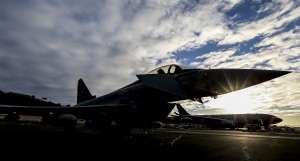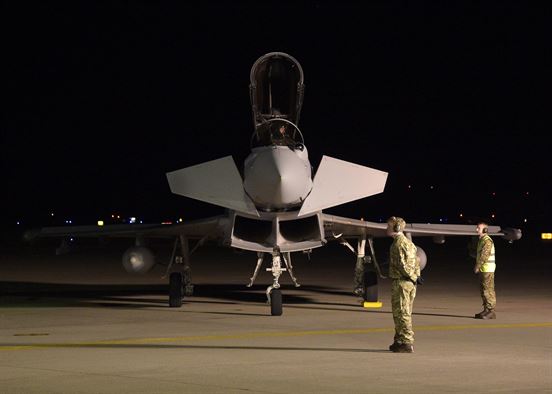2016-11-11 By Robbin Laird
During a visit to RAF Lossiemouth in June 2016, I had to discuss with an experienced Typhoon pilot now in 1 (F) Squadron, the evolution of Typhoon and its performance in recent Middle Eastern operations.
This pilot’s background was initially with the Army and then he became a Typhoon pilot and this is his fourth tour with Typhoon.
Given his background, his judgment about the migration of the Typhoon in its ground attack role is quite significant.
He has flown the Typhoon for a number of years, and was one of the first to fly with the USAF F-22s and been part of shaping interactive con-ops with the USAF’s initial fifth generation aircraft as well.

According to this pilot, the Tranche 1 Block 1 was really a developmental aircraft; and evolved into a pure air-to-air platform.
“When we flew the Typhoon in Libya, we performed our first real ground attack role, but we added the Enhanced Paveway in a relatively basic fashion.
It performed pretty well in 2011; but it was challenging to operate.”
When Tranche 2 entered the force, there was a solid foundation laid for shaping the way ahead for the evolution to the ground attack capabilities of the aircraft.
“The real upgrade to Tranche 2 was the Phase 1 enhancement.
It integrated Paveway IV into the aircraft; the integration provided a focused capability for the ground strike role.
The software completely changed with an enhanced capability to perform the ground attack role.
We now could direct the weapon to a variety of targets with the onboard control systems and software.
In the early Tranche 2 experience, the weapon was not integrated with the aircraft; with the evolution of Tranche 2 and the phase 1 enhancements, Paveway IV is completely integrated into the aircraft’s combat system.”
As he described Tranche 1 was far more challenging than Tranche 2 in order to target a ground attack weapon for the targeting pod could find a target, but the pilot would have to handle the weapons use manually.
The pilot was the sensor.
Now with Tranche 2, you can type in the targeting information and the plane will then provide the data to execute the strike mission.
“This capability has been demonstrated in Operation SHADER.
And the targeting capability was so effective that JTACS actually were calling for the Typhoon/Paveway IV capability on a regular basis.
We had combat mass and significant strike capability which could be delivered rapidly and coalition partners quickly began to pick up on this capability.”

As he described the performance, “we could operate a four ship formation and strike 16 targets in one pass.
We never could do that with Tranche 1.
And we provided close air support to our ground forces, and provide information to the ground forces to support their operations, with targeting information provided from the ground maneuver forces, or from our onboard sensors.”
The way ahead in his view is the integration of new weapons, such as the evolving Brimstone series, to expand the capabilities, which the Typhoon can deliver in the battlespace.
He argued that if the weapons envelope was expanded then the speed of the Typhoon could be leveraged to expand the attack profile of the aircraft.
In short, for this Typhoon pilot, the recent Operation SHADER experience highlights the new capabilities of Typhoon, and shapes in his mind a key way ahead.
“We can fly high and fast but we are limited by current generation weapons in terms of how we can use them.”
The evolution of Typhoon highlights the need for evolving the weapons capability of the aircraft to take advantage of the platform’s performance capabilities.
For an overview on 1 (F) Squadron, see the following:


